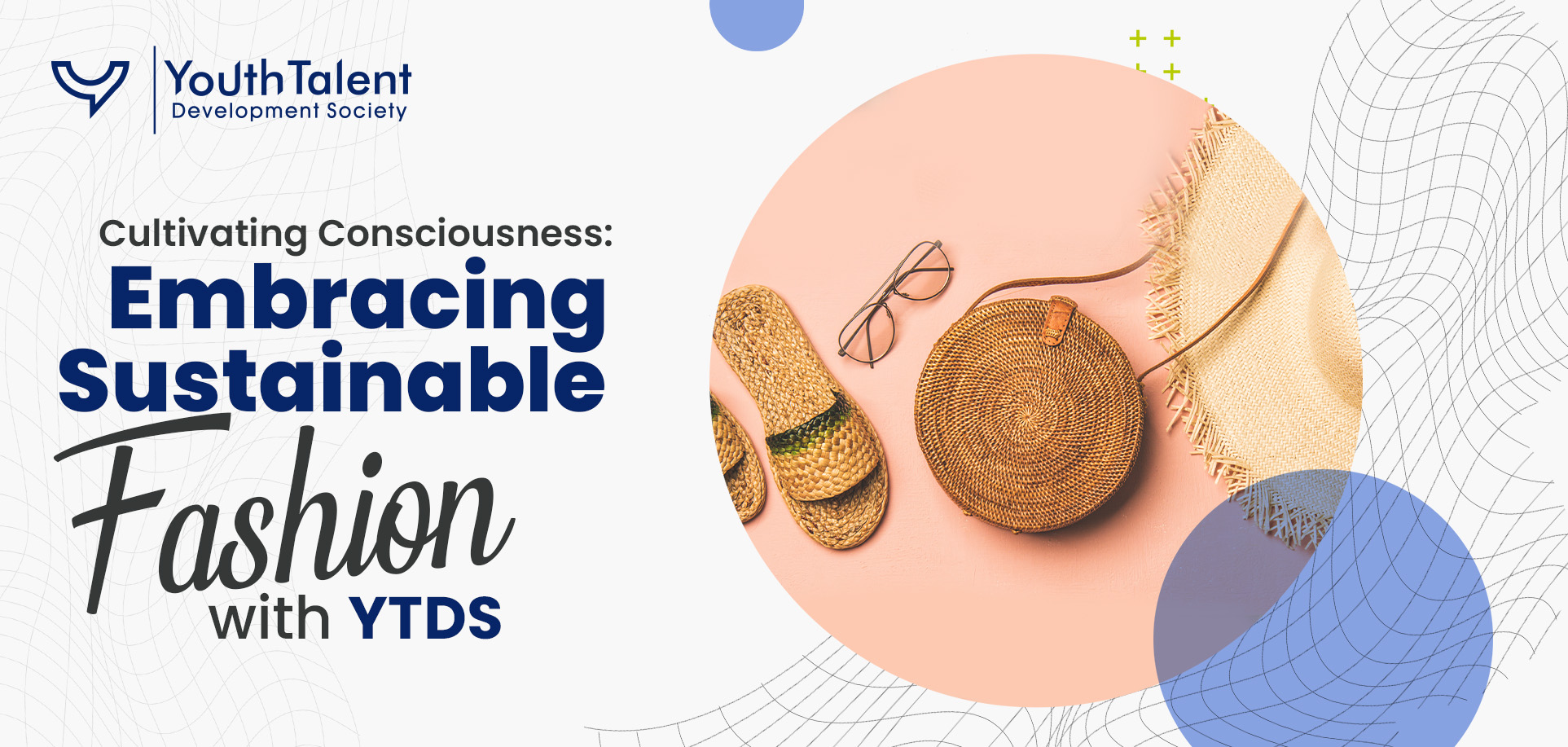
Cultivating Consciousness: Embracing Sustainable Fashion with YTDS
Since trends in fashion are constantly arising so fast; it is crucial to reflect on the way our clothes may impact both ecosystems and communities. This site not only informs you about catastrophic environmental consequences of the fashion industry, but it also gives an insight into sustainable clothes selection for eco conscious individuals. Let’s explore rapid fashion’s ethical dilemmas and how a capsule wardrobe could change everything we know about fashion. Furthermore, we will also discuss the transformative possibilities inherent within upcycling as well as how supporting YTDS’s “Plant A Million Trees” initiative might help save our environment from being completely swallowed by deforestation through its association with fashion industry practices. Let us delve deep into fashion as an instrument for good.
The Environmental Impact of Fashion:
The fashion industry has far-reaching and important effects on the environment. For example, contaminated water bodies and air pollution could be one of the noticeable harmful consequences. Surprisingly, it is estimated that this business contributes a large amount of greenhouse gas emissions released into the atmosphere annually, which is even more than those from international travel. Furthermore, according to the World Bank, dyeing and treating textiles makes up not less than 20 percent of industrial water pollution worldwide. These alarming statistics prove that the fashion industry must undergo radical changes with regard to its operations if it is to minimize its adverse environmental impacts and embrace sustainability.
Ethical Concerns in Fast Fashion:
Low-cost, high-volume production drives fast fashion, creating human rights breaches, hazardous working conditions, and labour exploitation in garment factories on a global scale, a pursuit that has strained ethical considerations within the industry centering on the issue of environmental stewardship. However, this industry is not only damaging through environmental impacts but also has raised ethical issues on fast fashion. In order to meet the hungry need for fast fashion, workers endure eerie hours, negligible pay and risky situations. Repeatedly are such workers the marginalized societies. By backing businesses that give more regard to propitious production approaches and fair labor standards, clients can help combat these injustices hence promoting social responsibility in this sector.
Moving Beyond Price: The True Cost of Clothing
Today’s consumer society is drawn to fast fashion because of its accessibility and affordability. However, we should ponder more about its real cost rather than looking at the initial price paid for the product by a customer. For instance, life span of the garment itself, its effect on garment workers lifestyle as well as environmental price of production methods all fall under here. We could select smart choices here which may emphasize more on greenness or permanence and by adopting a conscious consumer attitude you can choose one that focuses on quality more than fads and artificiality.
Capsule Wardrobe: Quality Over Quantity
One way to adopt sustainable fashion is to wear a capsule wardrobe. This consists of classic and adaptable clothes which one can combine to make several outfits. Consequently, customers can limit excessive purchases hence reducing harm on the environment, by spending on high-quality items that last for long time period. This is because you buy less when purchasing quality items and obtaining a distinct way that differs from trends.
Exploring Sustainable Alternatives:
Several options exist to replace ordinary purchasing ways of finding eco-friendly fashion. You can extend the life of your clothes through exchanges, second-hand shops and stores that deal in second-hand goods which are known as preowned clothing businesses; thus reducing waste created by worn out clothing materials . Giving away slightly worn-out outfits allows clients’ households to manage textile disposal while at the same time helping to promote circular production processes since they prevent nylons from entering garbage sites. Additionally, using natural and environmentally organic fibers such as Tencel, hemp or linen. Organic cotton decreases environmental damage and stimulates various forms of animal and plant life in the fashion industry. By selecting organic fabrics, people create demand for socially responsible and ecologically sensitive products that reduce environmental footprints.
Identifying Sustainable Brands:
In the fashion industry, conscious buying matters a lot. When selecting clothing, it is important to evaluate the outfit’s option for purchasing from sustainable companies by looking for certifications such as Fair Trade, Global Organic Textile Standard (GOTS), or Bluesign. Such documents certify the person’s adherence to the best practices with regard to environmental and social aspects. Moreover, proper sourcing, manufacturing, and distribution methods should be adhered to, while all actions around transparency are underscored. The fashion Industry is changing and now gives first priority to human and environmental stewardship, mainly because of many hands that work together in acts which ultimately bring about real change.
Embracing Upcycling: Transforming Old into New
Another sustainable way that is gaining a foothold in the fashion industry is called upcycling, which is the act of using old clothes or textiles and making new items. Options are endless, including converting old materials into original pieces, turning old jeans into fashionable handbags among others. Upcycling helps clients show their inventiveness, minimize surplus textile consumption, and back a more circular kind of fashion trade.Our attachment to things grows as we upcycle them and assign sentimental value in ways they weren’t meant to have.
The Link Between Fashion and Deforestation:
Throughout the globe, the fashion industry is devastating habitats and deforesting fragile ecosystems due to their need for raw materials like viscose that is made from wood pulp. It creates more climate change because trees are falling in order to create space for pulpwood plantation what also leads to decreasing biodiversity and lower carbon sequestering. In addition, Local communities together with Indigenous Peoples who depend on trees so as to maintain their traditional histories. In addition, deforestation affects local communities and indigenous people who depend on trees for their traditional history and survival ways negatively. By dealing with fundamental reasons for deforestation and promoting sustainable forestry practices, we can minimize the effect of fashion industry on global forests.
Supporting YTDS's #PlantAMillionTrees Movement:
The solution to the environmental issues that the fashion industry brings with it is to join YTDS’s #PlantAMillionTrees movement as a method of halting deforestation and promoting sustainable behavior. Consequently, from these reforested sites YTDS is able to reduce global warming in such areas, provide homes for various species and make the ecosystems less vulnerable. Equally important to remember is the fact that trees play a significant role in water preservation by taking up carbon dioxide which slows down the rate at which world temperatures rise. A process that is crucial as the carbon footprint within the fashion industry is high. By volunteering donating or raising awareness, the consumers may be able to redeem the environmental effect of what they buy and also contribute in developing a more sustainable tomorrow through supporting YTDS’s tree planting project.
Conclusion:
Simply put, sustainable fashion is not just a new look in clothes, it’s a new look at the world. It teaches consumers how to reduce waste, reuse materials, make high quality clothing, send old things in for recycling, upcycle them or even resell them to different customers on improved terms thus making some cash in the process. Besides, adopting sustainable fashion means more than just changing what hangs in your closet; it means transforming the entire globe. Let’s support campaigns like YTDS’s #PlantAMillionTrees to help save the environment and build a better world. We must put heads together in order to make people conscious of the need for environmental protection measures, and also pave way for our off springs so that they may inhabit a society that is equal for all and adapted to the reality of climate change.


